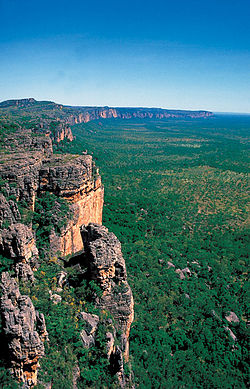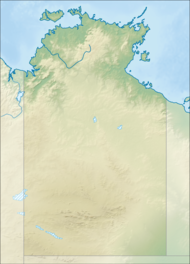Kakadu National Park
|
Kakadu National Park Northern Territory |
|
|---|---|
|
IUCN category II (national park)
|
|
| Nearest town or city | Jabiru |
| Coordinates | 12°25′16″S 132°40′23″E / 12.42111°S 132.67306°ECoordinates: 12°25′16″S 132°40′23″E / 12.42111°S 132.67306°E |
| Established | 5 April 1979 |
| Area | 19,804 km2 (7,646.4 sq mi) |
| Visitation | 250,000 (in 2002) |
| Managing authorities |
|
| Website | Kakadu National Park |
| See also | Protected areas of the Northern Territory |
| Kakadu National Park | |
|---|---|
| Name as inscribed on the World Heritage List | |
 |
|
| Location | Australia |
| Type | Other/Unknown |
| Criteria | i, vi, vii, ix, x |
| Reference | 147 |
| UNESCO region | Asia-Pacific |
| Inscription history | |
| Inscription | 1981(5th Session) |
| Extensions | 1987; 1992 |
Kakadu National Park is a protected area in the Northern Territory of Australia, 171 km southeast of Darwin.
The park is located within the Alligator Rivers Region of the Northern Territory. It covers an area of 19,804 km2 (7,646 sq mi), extending nearly 200 kilometres from north to south and over 100 kilometres from east to west. It is the size of Slovenia, about one-third the size of Tasmania, or nearly half the size of Switzerland. The Ranger Uranium Mine, one of the most productive uranium mines in the world, is surrounded by the park.
The name Kakadu may come from the mispronunciation of Gaagudju, which is the name of an Aboriginal language formerly spoken in the northern part of the park. This name may derive from the Indonesian word kakatuwah, (via Dutch kaketoe and German Kakadu) subsequently Anglicised as "cockatoo". Kakadu is ecologically and biologically diverse. The main natural features protected within the National Park include:
Aboriginal people have occupied the Kakadu area continuously for at least 40,000 years. Kakadu National Park is renowned for the richness of its Aboriginal cultural sites. There are more than 5,000 recorded art sites illustrating Aboriginal culture over thousands of years. The archaeological sites demonstrate Aboriginal occupation for at least 20,000 and possibly up to 40,000 years.
The cultural and natural values of Kakadu National Park were recognised internationally when the park was placed on the UNESCO World Heritage List. This is an international register of properties that are recognised as having outstanding cultural or natural values of international significance. Kakadu was listed in three stages: stage 1 in 1981, stage 2 in 1987, and the entire park in 1992.
...
Wikipedia

